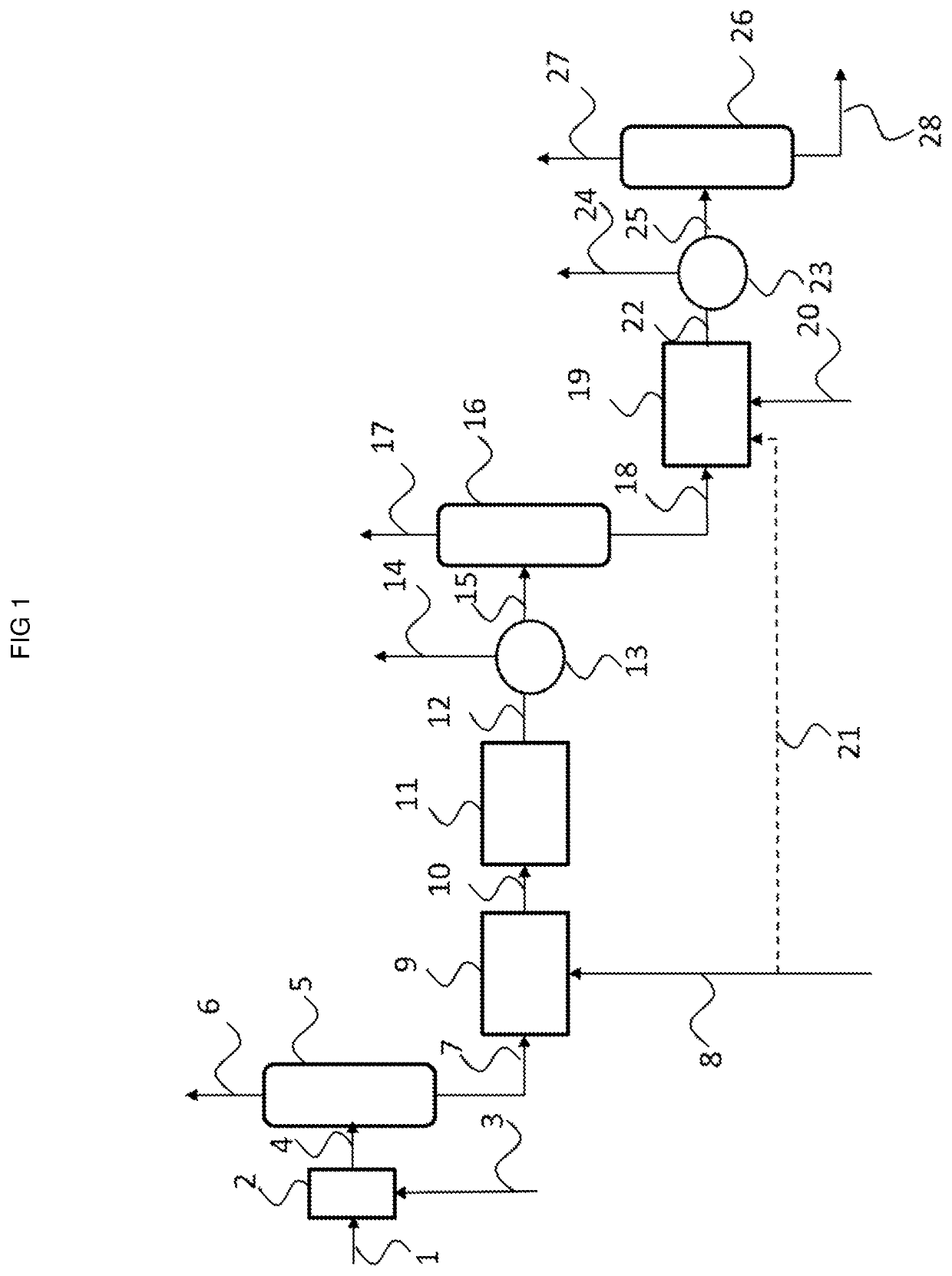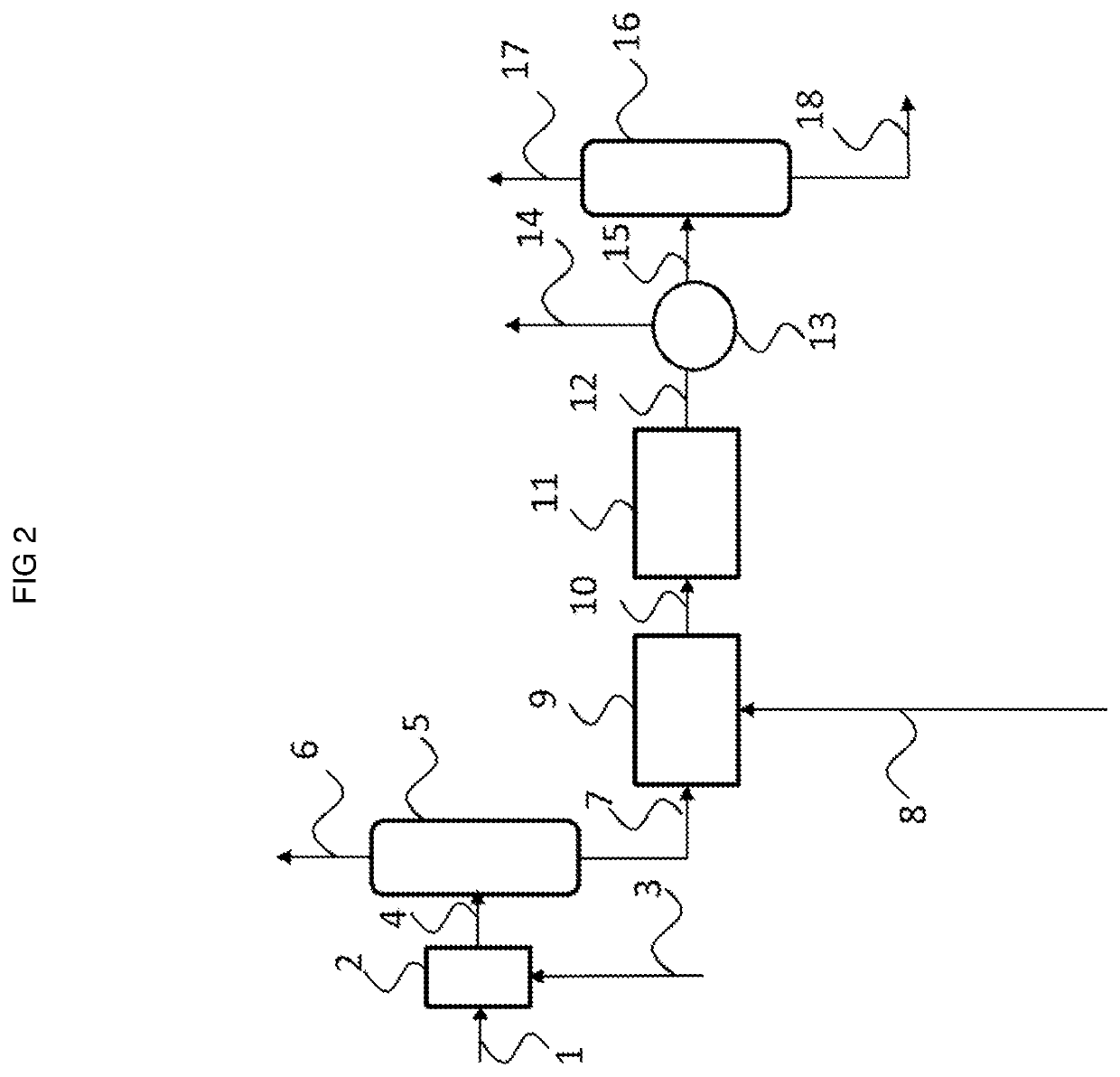Method for producing gasoline with low sulphur and mercaptan content
a technology of mercaptan and sulphur, which is applied in the direction of separation processes, fuels, chemistry apparatuses and processes, etc., can solve the problems of high octane loss, high hydrogen consumption, and the inability to increase the hsub>2/sub>/hc ratio without limit, and reduce the lifetime of catalysts
- Summary
- Abstract
- Description
- Claims
- Application Information
AI Technical Summary
Benefits of technology
Problems solved by technology
Method used
Image
Examples
example 1
ent of the FCC Gasoline Feedstock by Selective Hydrogenation (According to the Prior Art)
[0183]Table 1 gives the characteristics of an FCC gasoline treated by the process according to FIG. 2 of the prior art (EP 1 077 247).
[0184]The FCC gasoline (line 1) is treated in the selective hydrogenation reactor 2 in the presence of a catalyst A (optional stage). The catalyst A is a catalyst of NiMo type on gamma-alumina. The metal contents are respectively 7% by weight NiO and 11% by weight MoO3 with respect to the total weight of the catalyst, that is to say an Ni / Mo molar ratio of 1.2. The specific surface area of the catalyst is 230 m2 / g. Prior to use thereof, the catalyst A is sulfided at atmospheric pressure in a sulfidation bed under an H2S / H2 mixture consisting of 15% by volume of H2S at 1 l / g·h of catalyst and at 400° C. for two hours. This protocol makes it possible to obtain a degree of sulfidation of greater than 80%.
[0185]The gasoline (line 1) is brought into contact with hydrog...
example 2 (
Comparative According to the Prior Art): Hydrodesulfurization of the First Heavy Gasoline Cut
[0188]This example makes reference to the prior art (EP 1 077 247) and to FIG. 2. The first heavy gasoline cut (line 7) obtained in example 1 is mixed with hydrogen (line 8) and treated in a selective hydrodesulfurization unit (9), corresponding to a first hydrodesulfurization stage. The first hydrodesulfurization stage is conducted in the presence of a CoMo catalyst supported on alumina. The temperature is 268° C., the pressure is 2 MPa, the liquid space velocity (expressed in volume of liquid per volume of catalyst and per hour) is 3 h−1, the ratio of the hydrogen flow rate to the feedstock flow rate is 250 normal m3 per m3 under standard conditions. The effluent from the reactor (line 10) is then reheated in an oven (not shown in the figure) and then introduced into a second reactor (11) containing a “finishing” catalyst. This finishing stage is conducted in the presence of an Ni catalyst...
example 3
g to the Present Invention)
[0192]This example makes reference to the present invention, according to FIG. 1. The first heavy gasoline cut (line 7) obtained in example 1 is mixed with hydrogen and treated in a selective hydrodesulfurization unit (9), corresponding to stage a) of the present invention.
[0193]The first hydrodesulfurization stage (stage a)) is conducted in the presence of a CoMo catalyst supported on alumina. The temperature is 260° C., the pressure is 2 MPa, the liquid space velocity (expressed in volume of liquid per volume of catalyst and per hour) is 3 h−1, the ratio of the hydrogen flow rate to the feedstock flow rate is 200 normal m3 per m3 under standard conditions. The effluent from the reactor (line 10) is then reheated in an oven (not shown in the figure) and then introduced into a second reactor (11) containing a “finishing” catalyst, corresponding to stage b). This selective hydrodesulfurization stage is carried out in the presence of an Ni catalyst supported...
PUM
| Property | Measurement | Unit |
|---|---|---|
| pressure | aaaaa | aaaaa |
| pressure | aaaaa | aaaaa |
| temperature | aaaaa | aaaaa |
Abstract
Description
Claims
Application Information
 Login to View More
Login to View More - R&D
- Intellectual Property
- Life Sciences
- Materials
- Tech Scout
- Unparalleled Data Quality
- Higher Quality Content
- 60% Fewer Hallucinations
Browse by: Latest US Patents, China's latest patents, Technical Efficacy Thesaurus, Application Domain, Technology Topic, Popular Technical Reports.
© 2025 PatSnap. All rights reserved.Legal|Privacy policy|Modern Slavery Act Transparency Statement|Sitemap|About US| Contact US: help@patsnap.com



